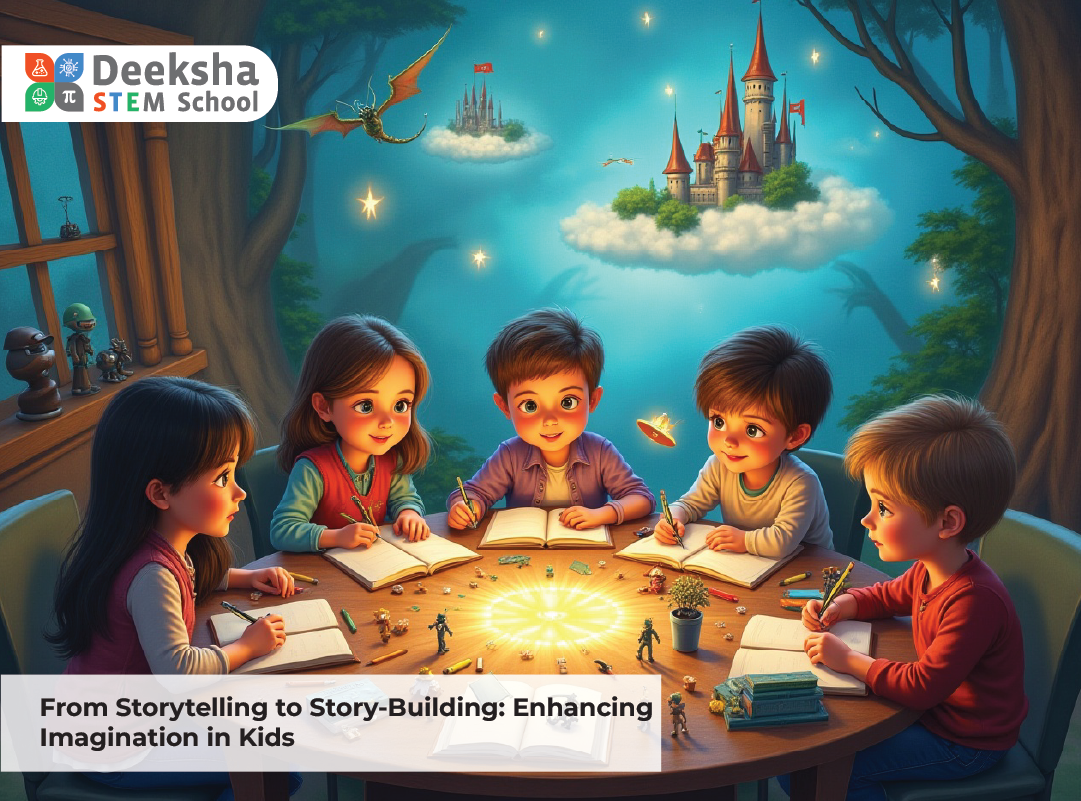From Storytelling to Story-Building: Enhancing Imagination in Kids

Stories are the oldest and most enduring form of human communication. From folklore passed down through generations to fairy tales told before bed, stories captivate, inspire, and teach. For children, stories aren’t just a form of entertainment—they’re a lens to explore the world, understand emotions, and develop critical thinking. But while storytelling is essential, an even more transformative approach is story-building—the process where children imagine, construct, and narrate their own stories.
At Deeksha STEM Schools, we believe in going beyond passive learning. Story-building turns children from mere listeners into thinkers, creators, and problem-solvers. When a child builds a story, they are not only practicing language skills but also using logic, empathy, and imagination. They are developing a powerful voice—and learning how to share it with clarity and confidence.
Why Story-Building Matters in Child Development
- Promotes Original Thinking: Children stretch their minds to develop plotlines, invent characters, and build unique worlds, sharpening their creativity.
- Improves Language Mastery: By crafting dialogue and descriptive text, they naturally improve vocabulary, sentence structure, and narrative fluency.
- Enhances Problem-Solving: Every story involves a conflict and resolution. This teaches kids to think critically and creatively about challenges and outcomes.
- Boosts Self-Confidence: Telling their own stories validates their thoughts, builds pride, and encourages self-expression.
- Supports Emotional Intelligence: When writing from different perspectives, kids develop empathy, understanding motivations and emotional responses.
- Develops Sequential Thinking: Story-building helps children organize ideas logically—beginning, middle, and end—improving their ability to structure thoughts in all areas of life.
Story-Building vs. Storytelling: What’s the Difference?
| Aspect | Storytelling | Story-Building |
| Role of the Child | Passive listener | Active creator and narrator |
| Outcome | Retention of known stories | Generation of original narratives |
| Learning Mode | Auditory | Visual, verbal, and cognitive |
| Skill Development | Listening and comprehension | Creativity, writing, and critical thinking |
| Emotional Engagement | Limited to author’s intent | Deep personal connection with the narrative |
| Application in Learning | Listening-based comprehension | Cross-disciplinary integration and innovation |
Through story-building, children internalize complex ideas more deeply than by simply listening. They are not just consuming content—they’re creating meaning.
How We Encourage Story-Building at Deeksha STEM
Imagination and innovation are embedded in our curriculum. Here’s how we make story-building a regular part of academic life:
- Story Labs: Fun, collaborative workshops where students brainstorm and build stories together using themes, objects, or images.
- Creative Writing Modules: We use imaginative prompts, story starters, and visual cues to guide structured creative writing.
- Drama and Roleplay: Students enact their stories, exploring tone, body language, and empathy through live performance.
- Story Mapping Tools: We teach visual frameworks like the story arc, character webs, and storyboard layouts to help students structure their ideas.
- Multimedia Projects: Storytelling expands beyond paper—kids use comic strip apps, podcasting tools, digital storytelling platforms, and even LEGO scenes to bring stories to life.
- Interdisciplinary Story-Building: Science stories about inventors, historical narratives from a child’s perspective, or mathematical adventures all reinforce learning while sparking creativity.
These practices allow students to step into the shoes of authors, illustrators, directors, and designers—boosting multi-dimensional thinking and collaboration.
Tips for Parents to Foster Story-Building at Home
- Ask daily open-ended questions like, “What adventure would you go on today?”
- Let children lead bedtime stories by creating their own endings or changing characters
- Start a family storybook where each member contributes one page
- Use prompts like story dice, pictures, or unusual objects to spark imagination
- Encourage digital storytelling through child-friendly apps or stop-motion animations
- Support all forms of expression—even oral stories or puppet shows count!
- Praise creativity, not perfection—stories don’t have to follow rigid grammar rules
Frequently Asked Questions
1. Isn’t storytelling enough for young kids?
- Storytelling is an excellent foundation, but story-building allows children to actively shape content. It engages higher-order thinking skills, encourages risk-taking in imagination, and builds narrative control.
2. How early can children begin story-building?
- Children as young as three can begin with picture-based stories or storytelling through play. As they grow, they can move into structured writing, digital creation, and group storytelling activities.
3. Can story-building help with shy or introverted kids?
- Absolutely. It provides a low-pressure way for introverted children to express themselves. Whether through writing, drawing, or small group work, story-building offers multiple safe mediums for communication.
4. Does Deeksha STEM integrate story-building across subjects?
- Yes. Story-building is used to enhance learning across science, history, language, and even math. Students might write a story from a plant’s perspective in biology or create a historical diary in social science.
5. What tools or resources does Deeksha STEM use?
- We incorporate writing journals, visual thinking tools, storytelling software, comic strip creators, and collaborative brainstorming platforms to make story-building diverse and accessible.
Final Thoughts
Story-building is more than just an academic activity—it’s a foundation for life. It cultivates imagination, strengthens empathy, and empowers children to believe that their ideas have value. Through the simple act of creating stories, children learn to lead, problem-solve, and connect with others.
At Deeksha STEM Schools, we don’t just teach lessons—we teach students how to explore, express, and evolve. Whether through a written tale, a digital comic, or a narrated animation, every story our students build is a step toward becoming thoughtful, articulate, and creative citizens.
Visit our campuses at Bannerghatta Road, Judicial Layout, Kengeri, and Vidyanagar to witness how imagination drives our classrooms—and how your child can be part of a story worth telling.




